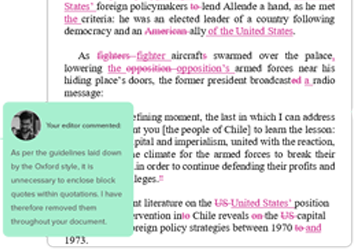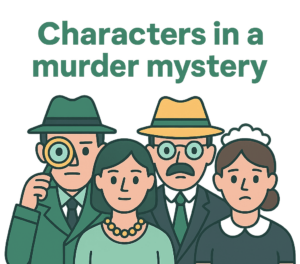- A List of Writing Contests in 2022 | Exciting Prizes!
- Em Dash vs. En Dash vs. Hyphen: When to Use Which
- Book Proofreading 101: The Beginner’s Guide
- Screenplay Editing: Importance, Cost, & Self-Editing Tips
- Screenplay Proofreading: Importance, Process, & Cost
- Script Proofreading: Rates, Process, & Proofreading Tips
- Manuscript Proofreading | Definition, Process & Standard Rates
- Tips to Write Better if English Is Your Second Language
- Novel Proofreading | Definition, Significance & Standard Rates
- Top 10 Must-Try Writing Prompt Generators in 2024
- 100+ Creative Writing Prompts for Masterful Storytelling
- Top 10 eBook Creator Tools in 2024: Free & Paid
- 50 Timeless and Unforgettable Book Covers of All Time
- What Is Flash Fiction? Definition, Examples & Types
- 80 Enchanting Christmas Writing Prompts for Your Next Story
- Your Guide to the Best eBook Readers in 2024
- Top 10 Book Review Clubs of 2025 to Share Literary Insights
- 2024’s Top 10 Self-Help Books for Better Living
- Writing Contests 2023: Cash Prizes, Free Entries, & More!
- Top 10 Book Marketing Services of 2024: Features and Costs
- What Is a Book Teaser and How to Write It: Tips and Examples
- Audiobook vs. EBook vs. Paperback in 2024: (Pros & Cons)
- How to Get a Literary Agent in 2024: The Complete Guide
- Alpha Readers: Where to Find Them and Alpha vs. Beta Readers
- Author Branding 101: How to Build a Powerful Author Brand
- A Guide on How to Write a Book Synopsis: Steps and Examples
- How to Write a Book Review (Meaning, Tips & Examples)
- 50 Best Literary Agents in the USA for Authors in 2024
- Building an Author Website: The Ultimate Guide with Examples
- Top 10 Book Printing Services for Authors in 2024
- 10 Best Free Online Grammar Checkers: Features and Ratings
- Top 10 Paraphrasing Tools for All (Free & Paid)
- Top 10 Book Editing Software in 2024 (Free & Paid)
- What Are Large Language Models and How They Work: Explained!
- Top 10 Hardcover Book Printing Services [Best of 2024]
- 2024’s Top 10 Setting Generators to Create Unique Settings
- Different Types of Characters in Stories That Steal the Show
- Top 10 Screenplay & Scriptwriting Software (Free & Paid)
- 10 Best AI Text Generators of 2024: Pros, Cons, and Prices
- Top 10 Must-Try Character Name Generators in 2024
- 10 Best AI Text Summarizers in 2024 (Free & Paid)
- 2024’s 10 Best Punctuation Checkers for Error-Free Text
- Top 10 AI Rewriters for Perfect Text in 2024 (Free & Paid)
- 11 Best Story Structures for Writers (+ Examples!)
- How to Write a Book with AI in 2024 (Free & Paid Tools)
- Writing Contests 2024: Cash Prizes & Free Entries!
- Patchwork Plagiarism: Definition, Types, & Examples
- 15 Powerful Writing Techniques for Authors in 2024
- Simple Resume Formats for Maximum Impact With Samples
- What Is a Complement in a Sentence? (Meaning, Types & Examples)
- What are Clauses? Definition, Meaning, Types, and Examples
- Persuasive Writing Guide: Techniques & Examples
- How to Paraphrase a Text (Examples + 10 Strategies!)
- 10 Best AI Writing Assistants of 2024 (Features + Pricing)
- Generative AI: Types, Impact, Advantages, Disadvantages
- A Simple Proofreading Checklist to Catch Every Mistake
- Top 10 AI Resume Checkers for Job Seekers (Free & Paid)
- 20 Best Comic Book Covers of All Time!
- How to Edit a Book: A Practical Guide with 7 Easy Steps
- How to Write an Autobiography (7 Amazing Strategies!)
- How to Publish a Comic Book: Nine Steps & Publishing Costs
- Passive and Active Voice (Meaning, Examples & Uses)
- How to Publish a Short Story & Best Publishing Platforms
- What Is Expository Writing? Types, Examples, & 10 Tips
- 10 Best Introduction Generators (Includes Free AI Tools!)
- Creative Writing: A Beginner’s Guide to Get Started
- How to Sell Books Online (Steps, Best Platforms & Tools)
- Top 10 Book Promotion Services for Authors (2025)
- 15 Different Types of Poems: Examples & Insight into Poetic Styles
- 25 Figures of Speech Simplified: Definitions and Examples
- 10 Best Book Writing Apps for Writers 2025: Free & Paid!
- Top 10 AI Humanizers of 2025 [Free & Paid Tools]
- Top 101 Bone-Chilling Horror Writing Prompts
- How to Write a Poem: Step-by-Step Guide to Writing Poetry
- Top 10 Book Writing Software, Websites, and Tools in 2025
- 100+ Amazing Short Story Ideas to Craft Unforgettable Stories
- The Top 10 Literary Devices: Definitions & Examples
- Top 10 AI Translators for High-Quality Translation in 2025
- Top 10 AI Tools for Research in 2025 (Fast & Efficient!)
- 50 Best Essay Prompts for College Students in 2025
- Top 10 Book Distribution Services for Authors in 2025
- Best 101 Greatest Fictional Characters of All Time
- Top 10 Book Title Generators of 2025
- Best Fonts and Sizes for Books: A Complete Guide
- What Is an Adjective? Definition, Usage & Examples
- How to Track Changes in Google Docs: A 7-Step Guide
- Best Book Review Sites of 2025: Top 10 Picks
- Parts of a Book: A Practical, Easy-to-Understand Guide
- What Is an Anthology? Meaning, Types, & Anthology Examples
- How to Write a Book Report | Steps, Examples & Free Template
- 10 Best Plot Generators for Engaging Storytelling in 2025
- 30 Powerful Poems About Life to Inspire and Uplift You
- What Is a Poem? Poetry Definition, Elements, & Examples
- Metonymy: Definition, Examples, and How to Use It In Writing
- 10 Best AI Detector Tools in 2025
- How to Write a CV with AI in 9 Steps (+ AI CV Builders)
- What Is an Adverb? Definition, Types, & Practical Examples
- How to Create the Perfect Book Trailer for Free
- Writing Contests 2025: Cash Prizes, Free Entries, and More!
- Top 10 Book Publishing Companies in 2025
- 14 Punctuation Marks: A Guide on How to Use with Examples!
- Translation Services: Top 10 Professional Translators (2025)
- What is a Book Copyright Page?
- Final Checklist: Is My Article Ready for Submitting to Journals?
- 8 Pre-Publishing Steps to Self-Publish Your Book
- 7 Essential Elements of a Book Cover Design
- How to Copyright Your Book in the US, UK, & India
- Beta Readers: Why You Should Know About Them in 2024
- How to Publish a Book in 2024: Essential Tips for Beginners
- ISBN Guide 2024: What Is an ISBN and How to Get an ISBN
- Book Cover Design Basics: Tips & Best Book Cover Ideas
- Why and How to Use an Author Pen Name: Guide for Authors
- How to Format a Book in 2025: 7 Tips for Book Formatting
- What is Manuscript Critique? Benefits, Process, & Cost
- How to Hire a Book Editor in 5 Practical Steps
- Self-Publishing Options for Writers
- How to Promote Your Book Using a Goodreads Author Page
- 7 Essential Elements of a Book Cover Design
- What Makes Typesetting a Pre-Publishing Essential for Every Author?
- 4 Online Publishing Platforms To Boost Your Readership
- Typesetting: An Introduction
- Quick Guide to Novel Editing (with a Self-Editing Checklist)
- 10 Best Self-Publishing Companies of 2024: Price & Royalties
- Self-Publishing vs. Traditional Publishing: 2024 Guide
- How to Publish a Book in 2024: Essential Tips for Beginners
- ISBN Guide 2024: What Is an ISBN and How to Get an ISBN
- How to Publish a Book on Amazon: 8 Easy Steps [2024 Update]
- What are Print-on-Demand Books? Cost and Process in 2024
- What Are the Standard Book Sizes for Publishing Your Book?
- Top 10 EBook Conversion Services for 2024’s Authors
- How to Market Your Book on Amazon to Maximize Sales in 2024
- Top 10 Hardcover Book Printing Services [Best of 2024]
- How to Find an Editor for Your Book in 8 Steps (+ Costs!)
- What Is Amazon Self-Publishing? Pros, Cons & Key Insights
- Manuscript Editing in 2024: Elevating Your Writing for Success
- Know Everything About How to Make an Audiobook
- A Simple 14-Point Self-Publishing Checklist for Authors
- How to Write an Engaging Author Bio: Tips and Examples
- Book Cover Design Basics: Tips & Best Book Cover Ideas
- How to Publish a Comic Book: Nine Steps & Publishing Costs
- Why and How to Use an Author Pen Name: Guide for Authors
- How to Sell Books Online (Steps, Best Platforms & Tools)
- A Simple Guide to Select the Best Self-Publishing Websites
- 10 Best Book Cover Design Services of 2025: Price & Ratings
- How Much Does It Cost to Self-Publish a Book in 2025?
- How to Self-Publish a Book: Tips and Prices (2025)
- Quick Guide to Book Editing [Complete Process & Standard Rates]
- How to Distinguish Between Genuine and Fake Literary Agents
- What is Self-Publishing? Everything You Need to Know
- How to Copyright a Book in 2025 (Costs + Free Template)
- How to start your own online publishing company?
- 8 Tips To Write Appealing Query Letters
- Self-Publishing vs. Traditional Publishing: 2024 Guide
- How to Publish a Book in 2024: Essential Tips for Beginners
- ISBN Guide 2024: What Is an ISBN and How to Get an ISBN
- What are Print-on-Demand Books? Cost and Process in 2024
- How to Write a Query Letter (Examples + Free Template)
- Third-person Point of View: Definition, Types, Examples
- How to Write an Engaging Author Bio: Tips and Examples
- How to Publish a Comic Book: Nine Steps & Publishing Costs
- Top 10 Book Publishing Companies in 2025
- How to Create Depth in Characters
- Starting Your Book With a Bang: Ways to Catch Readers’ Attention
- Research for Fiction Writers: A Complete Guide
- Short stories: Do’s and don’ts
- How to Write Dialogue: 7 Rules, 5 Tips & 65 Examples
- What Are Foil and Stock Characters? Easy Examples from Harry Potter
- How To Write Better Letters In Your Novel
- On Being Tense About Tense: What Verb Tense To Write Your Novel In
- How To Create A Stellar Plot Outline
- How to Punctuate Dialogue in Fiction
- On Being Tense about Tense: Present Tense Narratives in Novels
- The Essential Guide to Worldbuilding [from Book Editors]
- What Is Point of View? Definition, Types, & Examples in Writing
- How to Create Powerful Conflict in Your Story | Useful Examples
- How to Write a Book: A Step-by-Step Guide
- How to Write a Short Story in 6 Simple Steps
- How to Write a Novel: 8 Steps to Help You Start Writing
- What Is a Stock Character? 150 Examples from 5 Genres
- Joseph Campbell’s Hero’s Journey: Worksheet & Examples
- Novel Outline: A Proven Blueprint [+ Free Template!]
- Character Development: 7-Step Guide for Writers
- What Is NaNoWriMo? Top 7 Tips to Ace the Writing Marathon
- What Is the Setting of a Story? Meaning + 7 Expert Tips
- Theme of a Story | Meaning, Common Themes & Examples
- What Is a Blurb? Meaning, Examples & 10 Expert Tips
- What Is Show, Don’t Tell? (Meaning, Examples & 6 Tips)
- How to Write a Book Summary: Example, Tips, & Bonus Section
- How to Write a Book Description (Examples + Free Template)
- 10 Best Free AI Resume Builders to Create the Perfect CV
- A Complete Guide on How to Use ChatGPT to Write a Resume
- 10 Best AI Writer Tools Every Writer Should Know About
- How to Write a Book Title (15 Expert Tips + Examples)
- 100 Novel and Book Ideas to Start Your Book Writing Journey
- Exploring Writing Styles: Meaning, Types, and Examples
- Mastering Professional Email Writing: Steps, Tips & Examples
- How to Write a Screenplay: Expert Tips, Steps, and Examples
- Business Proposal Guide: How to Write, Examples and Template
- Different Types of Resumes: Explained with Tips and Examples
- How to Create a Memorable Protagonist (7 Expert Tips)
- How to Write an Antagonist (Examples & 7 Expert Tips)
- Writing for the Web: 7 Expert Tips for Web Content Writing
- 10 Best AI Text Generators of 2024: Pros, Cons, and Prices
- What are the Parts of a Sentence? An Easy-to-Learn Guide
- How to Avoid AI Detection in 2024 (6 Proven Techniques!)
- How to Avoid Plagiarism in 2024 (10 Effective Strategies!)
- What Is Climax Of A Story & How To Craft A Gripping Climax
- What Is a Subject of a Sentence? Meaning, Examples & Types
- Object of a Sentence: Your Comprehensive Guide
- What Is First-Person Point of View? Tips & Practical Examples
- Second-person Point of View: What Is It and Examples
- 10 Best AI Essay Outline Generators of 2024
- Third-person Point of View: Definition, Types, Examples
- The Importance of Proofreading: A Comprehensive Overview
- Patchwork Plagiarism: Definition, Types, & Examples
- Simple Resume Formats for Maximum Impact With Samples
- The Ultimate Guide to Phrases In English – Types & Examples
- Modifiers: Definition, Meaning, Types, and Examples
- What are Clauses? Definition, Meaning, Types, and Examples
- Persuasive Writing Guide: Techniques & Examples
- What Is a Simile? Meaning, Examples & How to Use Similes
- Mastering Metaphors: Definition, Types, and Examples
- 10 Best AI Writing Assistants of 2024 (Features + Pricing)
- Generative AI: Types, Impact, Advantages, Disadvantages
- How to Publish a Comic Book: Nine Steps & Publishing Costs
- Essential Grammar Rules: Master Basic & Advanced Writing Skills
- Benefits of Using an AI Writing Generator for Editing
- Hyperbole in Writing: Definition and Examples
- 15 Best ATS-Friendly ChatGPT Prompts for Resumes in 2025
- How to Write a Novel in Past Tense? 3 Steps & Examples
- 10 Best Spell Checkers of 2025: Features, Accuracy & Ranking
- Foil Character: Definition, History, & Examples
- 5 Key Elements of a Short Story: Essential Tips for Writers
- How to Write a Children’s Book: An Easy Step-by-Step Guide
- How To Write a Murder Mystery Story
- What Is an Adjective? Definition, Usage & Examples
- Metonymy: Definition, Examples, and How to Use It In Writing
- Fourth-Person Point of View: A Unique Narrative Guide
- How to Write a CV with AI in 9 Steps (+ AI CV Builders)
- What Is an Adverb? Definition, Types, & Practical Examples
- How to Write A Legal Document in 6 Easy Steps
- 10 Best AI Story Generators in 2025: Write Captivating Tales
- How to Introduce a Character Effectively
- What is Rhetoric and How to Use It in Your Writing
- How to Write a Powerful Plot in 12 Steps
- How to Make Money as a Writer: Your First $1,000 Guide
- How to Write SEO Content: Tips for SEO-Optimized Content
- Types of Introductions and Examples
- How to Create Marketing Material
Still have questions? Leave a comment

Checklist: Dissertation Proposal
Enter your email id to get the downloadable right in your inbox!

Examples: Edited Papers
Enter your email id to get the downloadable right in your inbox!
Need
Editing and
Proofreading Services?

How To Write a Murder Mystery Story
 May 05, 2025
May 05, 2025 5
min read
5
min read
- Tags: Book Writing, Fiction, Novel, Novel Writings, Writer, Writing Tips
A satisfying murder mystery tale is one that’s well-crafted. There’s nothing quite like it, is there? The high stakes, the building tension, and the way the author lures you into rooting for the detective truly take immense skill and attention to craft. What are the things you should consider while crafting a murder mystery story? Let’s get straight into it!
“Ah, but my dear sir, the why must never be obvious. That is the whole point.” — Agatha Christie
Turn Your Murder Mystery into a Published Book! Get Started
Introduction to the murder mystery genre
The murder mystery genre is a captivating and enduring form of storytelling that has fascinated readers for generations. At its core, a murder mystery revolves around a crime, typically a murder, and the subsequent investigation to uncover the truth. A good murder mystery should keep readers guessing until the very end, with a surprising twist that is both unexpected and satisfying. To write a compelling murder mystery story, it’s essential to understand the key elements of the genre, including the importance of character development, plot twists, and red herrings. By weaving these elements into your narrative, you can create a story that keeps readers engaged and entertained from start to finish.

Understanding the key elements
A well-crafted murder mystery is a complex puzzle that involves multiple suspects, motives, and clues. The key elements of a murder mystery include a murder victim, a detective or amateur sleuth, and a list of potential suspects. The story should be rich with plot twists and turns, as well as red herrings to keep the reader guessing. A satisfying ending that ties up all the loose ends and provides closure is crucial. By understanding these key elements, writers can create a well-structured and engaging murder mystery story that captivates readers and keeps them on the edge of their seats.
A. Write a superior plot
1. Plot the story backward
You’ve decided who the killer is? Great! But are you sure about how things get there?
It’s at this point that you work towards tightening the plot.
The essence of a murder mystery story is that everything should make sense in the end. There can be no loose ends, and no questions can be left unanswered. A strategy to avert this is to work backward. Think carefully about how things got to the moment of the big reveal. Obviously, you don’t get to spell it out in a linear fashion, but it all has to be in your head.
When a writer plans the story backward, it ensures that every detail aligns perfectly. Plotting meticulously is crucial to ensure all elements of the story fit together logically.
You can do this in a few layers:
- Once you know who the killer is going to be, start thinking about how they committed the crime and what their motivations might have been.
- Then, think about their alibi, who they may have confided in, and how they go about hiding their crime.
- Introduce detectives, police, or investigators in the mix. To make the plot more believable, put yourself in their shoes and start thinking about how you would carry out the investigation. Think about loopholes and missing links that the killer has left. These clues will help you chart the investigator’s path.
Bonus tip: Bear in mind, if you’re doing this on your own, that you may come to convenient solutions because you know the end already. It’s a good idea to run your story by someone, a friend or a fellow writer, to see if it makes sense logically.
2. Think about where you’re leaving breadcrumbs
By ‘breadcrumbs’ we mean clues, of course.
When a reader gets to the end of the story, they’re not thrown new information. Instead, they reexamine existing information—little hints they hadn’t previously considered—to make sense of what’s happened. Paying attention to the little details is crucial in crafting a believable narrative. What you’re looking to evoke here is an epiphany, not a reveal.
It is also essential to provide the reader with all the clues necessary to solve the mystery. This ensures they have access to the same information as the detective, allowing them to piece together all the clues and feel like co-detectives.
In other words, clues should be hidden in plain sight. You can do this through two techniques: foreshadowing and misdirection. What are these?
Foreshadowing is a literary device that is used to hint at significant events or moments that come later in the story. Subtlety is of utmost importance here, and your readers should be curious to unravel its significance.
Readers are often unsatisfied if something is revealed abruptly, so foreshadowing is your safeguard against a random twist. Once the twist happens, and the reader tries to find out how it happened, they should land on whatever you’ve hinted at. Foreshadowing should be subtle but logical, and overtly obvious in hindsight.
Misdirection is the act of diverting your reader’s attention from an important clue. In magic, misdirection is often used as a technique of deception to keep the audience’s attention elsewhere so that the trick is carried out successfully.
Likewise, in fiction, writers often use this technique to distract readers from elements that will later gain importance in the narrative. This may happen through the narration or through ‘misguided’ deductions of a character. (The latter, for example, often happens in Holmes stories, where you’re seeing the world through Dr. Watson’s eyes.) Logically speaking, if this character comes to an erroneous conclusion, so will the reader. Instead, drop hints that readers refer to later that are external to what the character is saying or seeing.
B. Write a tension-rich story
3. Begin with action
What you need here is a killer hook. (Sorry, just couldn’t resist!)
The murder mystery is a genre that’s all about action. So it’s advised that you start writing with an action-packed incident, rather than a description of the setting or a philosophical pondering about the nature of things. Ensure that this event is intriguing, and a reader is compelled to find out what happened and how things came to be. An obvious type of incident is the discovery of a body. Writing a murder mystery can be fun and engaging for both the writer and the reader.
4. Build tension in every scene
The conflict between the killer and the investigator is at the core of a murder mystery story. Understanding the murderer’s motives can build tension by providing depth to the antagonist’s actions and making the detective’s pursuit more compelling. Even if the two parties don’t actually meet for the majority of the story, the reader should sense the tension of the cat-and-mouse chase between them.
You can do this by having the detective miss clues that you, the reader, are already exposed to, or through instances where the killer is almost caught but manages to slip away. Additionally, leading readers in the wrong direction with cleverly planted clues can maintain suspense and enhance the surprise of the plot twist.
5. Every character should have a rich backstory

In order to make the characters realistic, they should be more than simply stock characters who exist to perform specific actions in your book. The danger with a murder mystery is that a high focus on the plot may lead you to put characters in the backseat. However, developing other characters is crucial as it enriches the story and enhances interactions among characters. But in fact, characters are tremendously useful in fleshing out the details of the whole story. For instance, if you have witnessed interrogations in your story, you can use various characters’ alibis to give multiple perspectives of the same event, situation, or even suspect.
All characters, including suspects and the detective, should be well-developed to enrich the narrative. Well-developed characters contribute significantly to plot progression and create engaging conflict, ultimately enhancing the reader’s experience and the complexity of the mystery.
6. Craft a powerful twist
A powerful twist is the hallmark of a good murder mystery. It should be surprising yet make perfect sense in retrospect, providing a satisfying conclusion to the story. To craft a powerful twist, consider the murderer’s motives and the clues that have been subtly planted throughout the narrative. The twist should be unexpected but logical, delivering a sense of surprise and satisfaction for the reader. By carefully crafting a powerful twist, you can create a memorable and engaging murder mystery story that will keep readers talking long after they’ve turned the final page.
7. Avoid common mistakes
When writing a murder mystery, there are several common pitfalls to avoid. One significant mistake is introducing too many suspects, which can make the story confusing and difficult to follow. Another is using too many red herrings, which can leave the reader feeling cheated or misled. Additionally, avoid relying on convenient coincidences or contrived plot devices, as these can detract from the story’s credibility and suspense. By steering clear of these common mistakes, you can create a well-crafted and engaging murder mystery story that keeps readers hooked and entertained.
8. The importance of editing
Editing is a crucial step in the writing process, especially for murder mysteries. A good editor can help refine your plot, develop your characters, and ensure that your story is well-structured and engaging. Editing can also help you avoid common mistakes, such as inconsistencies in the plot or characters, and ensure that your story is free of errors and contradictions. By working with a skilled editor, you can create a polished and compelling murder mystery story that keeps readers guessing until the very end. Whether you’re writing a short story or a full-length novel, editing is an essential step in crafting a suspenseful and satisfying murder mystery that leaves readers eager for more.
Some general tips
- Read as much as you can: To familiarize yourself with the genre, to understand (through analysis) how a murder mystery is crafted, and to gain a sense of how such a tale is written.
- Don’t defy basic laws of science (especially medicine), the exception being if it directly makes sense to your plot. Readers can recognize a lapse in logic, and it takes away from realism.
Here are some more story-writing resources for you:

Tanvi

With a foundation in Life Sciences, Tanvi enjoys curating technical writing tips tailored for ESL students. When she's not translating complex concepts into bite-sized nuggets, she can be found playing with dogs or painting landscapes.
One comment on “How To Write a Murder Mystery Story”
Comments are closed.






Good day very nice web site!! Man .. Excellent .. Amazing .. Jilli Zachery Kingdon